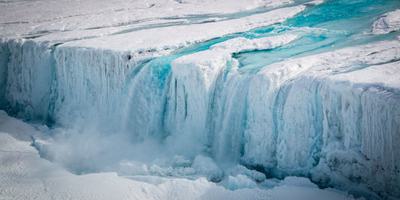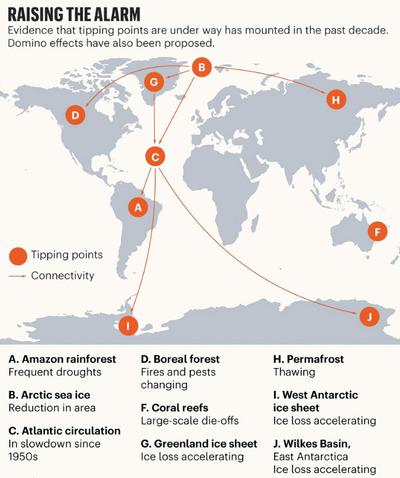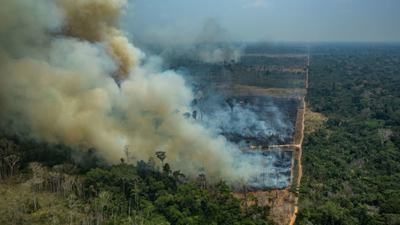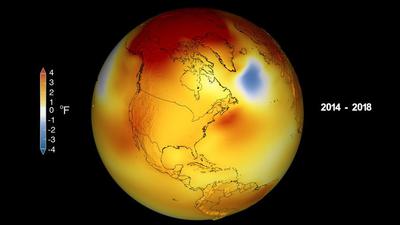Researchers’ biggest fear is for the future of the ocean circulation system, which moves heat around the world and may dictate global climate.
The researchers once considered these tipping points to be largely independent of each other. Now they warn that the world faces a “cascade” of abrupt shifts in the planet’s climate system, as global warming takes hold. “We might already have crossed the threshold for a cascade of inter-related tipping points,” they wrote in Nature. This “could trigger a shift in the state of the Earth system as a whole,” one of the authors, Will Steffen of the Australian National University in Canberra, told Yale Environment 360.
Their biggest fear is for the future of the global ocean circulation system, which moves heat around the world and may dictate global climate. They say melting Greenland ice in a warmer Arctic has driven a key component of ocean circulation to a thousand-year low. Further decline, which would lead to a shift in heat distribution around the planet, could trigger forest collapse in the Amazon; cause near-permanent drought in Africa’s Sahel region; disrupt Asian monsoons; rapidly warm the Southern Ocean, which would cause a surge in global sea levels as the West Antarctic Ice Sheet disintegrates; and potentially shift the planet to a new climate regime they call “hothouse Earth.”
The nine active climate tipping points. Credit: Nature
One climate scientist, Mike Hulme of the University of Cambridge, dismissed the new analysis as “a speculative opinion from a small group of self-selecting scientists.” He added that “there are no new research findings presented here” and that “many earth systems scientists would challenge the view” that the earth is close to crossing major tipping points. Lenton and his co-authors accept there is speculation involved, but argue that “given its huge impact and irreversible nature… to err on the side of danger is not a responsible option.”
The “climate emergency” is not just political rhetoric, they argue. It is now an identifiable scientific fact. Their message to the latest UN climate negotiations, under way in Madrid this week, is that the world may be almost out of time to prevent what they call an “existential threat to civilization.” Their study was released as a new report said that greenhouse gas emissions have hit a record high, with 40.6 billion tons of CO2 being pumped into the atmosphere in 2019.
The term “climate tipping points” was first coined 15 years ago by Hans Joachim Schellnhuber, former director of the Potsdam Institute for Climate Impact Research in Germany and a co-author of the new analysis, to describe how, under pressure from global warming, parts of the climate system could suddenly collapse or run out of control.
In their new analysis, the researchers conclude that of the 15 potential tipping points they identified in 2008, seven now show signs of being “active,” along with two others they have added to their list.“ That doesn’t mean a tipping point has necessarily been reached,” says Lenton. “But it means the system in question is showing evidence of change, of heading in the wrong direction.”
Four of these nine active tipping points involve thawing ice. Arctic sea ice is rapidly disappearing, and ice loss is accelerating on all three of the planet’s large, land-based ice sheets: Greenland, West Antarctica, and the Wilkes Basin in East Antarctica. Lenton says two of these, the West Antarctic Ice Sheet and Wilkes Basin, “are showing evidence consistent with having passed a tipping point,” meaning further ice loss may be unstoppable.
Greenland may not be far behind.“ Models suggest that the Greenland Ice Sheet could be doomed at 1.5 degrees C [2.7 degrees F] of warming, which could happen as soon as 2030,” the researchers report. Exceeding the three ice sheet tipping points could eventually cause an irreversible rise in sea levels of about 13 meters (43 feet), says Lenton.
Unlike the slowly deteriorating ice sheets, passing biospheric tipping points will produce abrupt, immediate, and obvious changes.
This may take centuries or millennia to play out, as the ice sheets slowly disappear into the ocean. But it will be virtually unstoppable, because once a thaw sets in, the surface of the ice sheet is lowered, exposing it to ever warmer air at lower altitudes.
Four more of the already-active tipping points involve the biosphere and its stores of carbon. The Amazon is suffering recurring droughts and forest dieback. In the boreal forests of the far north, rising temperatures are triggering epidemics of forest fires and pests. Meanwhile, permafrost is thawing and releasing methane, a greenhouse gas; and in the tropics, coral reefs are suffering massive die-offs, threatening wider ocean ecosystems.
Unlike the slowly deteriorating ice sheets, passing biospheric tipping points will often produce abrupt, immediate, and obvious changes, say the researchers. These may also be imminent. For instance, deforestation in the Amazon is already reducing rainfall and lengthening the dry season to a point where the rest of the trees die or are consumed by fires.
Carlos Nobre of the University of Sao Paulo, who was not involved in the present analysis, says that “when the dry season becomes longer than four months, tropical forest turns to savanna.” He puts the Amazon tipping point at 40-percent tree loss, a figure that changing global climate could reduce to between 20 and 25 percent by 2050. That is disturbingly close to the current total loss, reckoned to be approaching 20 percent.
Forest fires in the Amazon in the state of Rondônia, Brazil in August 2019. Victor Moriyama / Greenpeace
Lenton says abrupt releases of CO2 from these natural carbon stores would drastically reduce the leeway the world has for avoiding global warming above 1.5 degrees, the preferred target set by the 2015 Paris Agreement. That probably requires limiting future CO2 emissions to about 500 billion tons — roughly 12 years’ emissions at current rates. But abrupt forest dieback in the Amazon and boreal forests, coupled with methane emissions from thawing permafrost, could use up 300 billion tons of that emissions budget, Lenton says.
The basic mechanisms behind these tipping points have been well-known for some years, though the predictions of the time it will take before they are activated have become much shorter. But the real new concern, says Lenton, is the identification of the potential for tipping point “cascades,” in which breaching one tipping point triggers breaches of others, leading to a rapid escalation of damage.
Lenton, Steffen, and others argued last year that 2 degrees C of warming “could activate… a domino-like cascade that could take the Earth system to even higher temperatures.” Such a change to what they called “hothouse Earth” would be irreversible, they said, even if greenhouse gas emissions were brought to zero.
The lynchpin of one such cascade, they say, is the ninth tipping point that they have identified to be active — a critical feature of the global ocean circulation system, centered in the North Atlantic and known as the Atlantic Meridional Overturning Circulation (AMOC).
“In our view, the evidence from tipping points alone suggests that we are in a state of planetary emergency,” the scientists wrote.
The AMOC is currently initiated by evaporation of warm water moving north, which leaves behind saltier, denser water that sinks to the sea bed. It is responsible for driving the ocean circulation, distributes heat around the globe, and may be the prime regulator of the climate.
Stefan Rahmstorf, an oceanographer at the University of Potsdam and a co-author of the new analysis, told e360: “The AMOC stands at the center of tipping-point cascades because of its large-scale heat transport.” It is, he says, the main reason why the Northern Hemisphere is warmer than the Southern Hemisphere. But it is being disrupted.
“Arctic warming and Greenland melting are driving an influx of fresh water into the North Atlantic,” he says. The fresher water is less dense and sinks less. Rahmstorf calculates that, as a result, the AMOC has weakened by about 15 percent since global warming took hold in 1975. “It is now at its weakest in the past millennium, or even longer,” he says.
This decline of the ocean circulation threatens to trigger other tipping points elsewhere. “A slowdown of the AMOC reduces rainfall over the Amazon basin, increasing the probability of crossing a tipping point there,” says Steffen. It could also mess with monsoon systems in Asia and West Africa, triggering drought in the Sahel. And by bringing warm waters into the Southern Ocean, it would further destabilize ice in Antarctica, unleashing an acceleration in global sea level rise.
Most climate models predict a continued weakening of the AMOC through the 21st century. It remains unclear how close it might be to a tipping point, the researchers admit. But Lenton says that historically the AMOC appears to jump between different stable states. “The question,” says co-author Johan Rockstrom, who is director of the Potsdam Institute for Climate Impact Research, “is, what are the pressure points where we might cross a threshold and trigger a state change?”
Temperature anomalies from 2014-2018, in degrees Fahrenheit. Meltwater from Greenland has created a pocket of cold, fresh water (seen in blue) in the northern Atlantic Ocean, which scientists say could disrupt global ocean circulation. NASA
In the face of this threat, the researchers wade into the political debate about whether — as the European Parliament voted last month — the world should declare a climate emergency. “In our view, the evidence from tipping points alone suggests that we are in a state of planetary emergency,” their Nature paper concludes.
They justify this claim by attempting to define a climate emergency in mathematical terms, as a product of the extent of the threat, the probability of it happening, and the urgency, defined as how much time we have left to act. They argue that the current climate crisis fits that definition, with huge risks, increasing likelihood, and time fast running out.
This claim has drawn fire from some scientists. Hulme says such a calculation is “deeply misleading and dangerous… It is a bid by these scientists to place themselves as arbiters of whether or not we are in a climate emergency.” It is for society as a whole to decide what an emergency is, not scientists, he said.
“I am definitely not bidding to be an arbiter of climate emergency,” insists Lenton. “I am just trying to offer some scientific support for the already loud societal claims for climate emergency.” Referring to ongoing global youth protests demanding action to reduce greenhouse gas emissions, Lenton added, “The schoolkids are right.”
“We need to reach a social tipping point,” of low-carbon living, says an expert, “before we reach a planetary one.”
Hulme is also concerned about unintended consequences, such as encouraging politicians to embark on geo-engineering projects like deploying devices to shade us from solar radiation. “Calling a planet-wide emergency,” says Hulme, “can only accelerate the day when solar climate engineering is actively pursued” — something he opposes. Hulme and Lenton signed a joint statement, published in Nature Climate Change in 2015, warning of just such an eventuality.
Lenton says he remains opposed to geo-engineering, which he calls “as risky as the risks we are trying to avoid.” He thinks the threats the world faces are too great for scientists to stand on the political sidelines, especially given the world’s current failure to act to head off climate disaster.
“The current approach of the UN Climate Change Convention is a failure,” says Steffen. But he is not without hope. He believes declining fertility, innovation towards low-carbon energy, and growing movements for “greener” consumption all suggest that human society may be reaching its own tipping point in responding to the crisis. The bottom line, he says, is that “we need to reach a social tipping point, before we reach a planetary one.”






